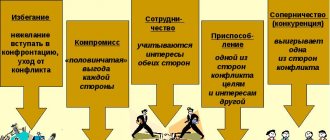TYPE A PERSONALITY AS A PSYCHOLOGICAL PHENOMENON
The concepts of “type A personality” and “type A behavior” came to personality psychology from psychosomatic medicine. M. Friedman and R. Rosenman (M. Friedman, R. Rosenman, 1975) described in detail this type, the characteristics of its behavior and the psychosomatic consequences to which such behavior leads. Analysis of these and many other studies ultimately led to the formation of a fairly strong belief that type A behavior and the possession of personality traits of this type are a risk factor for psycho-emotional distress.
What is included in the concept of “type A personality” and in the A-behavior pattern? The core of a type A personality is a strongly expressed desire for primacy, social superiority, the perception of life as an arena of competition, the always relevant desire to be invariably the first, the best. Moreover, the desire to be the first and the best in everything that a type A personality does. Not only in the main business, in the profession, but also in all secondary matters and hobbies. It is important to be the first in your professional activities, but it is also important to be the best when playing football or tennis, for example. And if you take up collecting, then “my collection should be the best.” And so in all spheres of social interaction of a type A personality. In addition, a personality of this type at the behavioral level is characterized by a vivid manifestation of activity, tension, ambition, often incontinence in expressing feelings, assertiveness and impatience in achieving a goal. When faced with obstacles on the way to achieving a goal, a Type A personality can often show not only persistence, but also aggressiveness. However, we emphasize that the core of personality is precisely the dominant motivation of primacy and social competition noted above.
Another commonly used name for Type A personality is coronary type. It is no coincidence that the fundamental work of M. Friedman and Rosenman, devoted to the description of the phenomenon of the type A personality, is called “Type A and its heart.” Numerous studies have found that cardiovascular diseases (heart attacks, strokes) occur in Type A individuals much more often, approximately twice as often as in other people. This circumstance is naturally associated by specialists with the personal and behavioral characteristics of Type A people. The stressogenic nature of such a personality pattern and such behavior is recognized as obvious. Consideration of type A behavior as a risk factor for psycho-emotional distress is also recognized as obvious.
The prevalence of type A personalities varies in different sociocultural populations and ranges from 45% to 76%. There are more such people in cities than in villages, and there are also more of them in socially and economically more developed regions (and countries) than in less developed ones. Combining these two trends, therefore, we can say that the maximum concentration of type A people will be observed in the cities of socio-economically more developed countries, and the minimum - in villages, which are also located in underdeveloped regions.
Additional interesting information on this matter is provided by studies of the phenomenon of longevity. In the early eighties, a large, comprehensive joint Soviet-American study of the phenomenon of longevity was completed. The subject of the study was the lifestyle of both the centenarians themselves and other people from those regions that produce a high percentage of centenarians. In the USSR, the study was carried out in the Republic of Abkhazia, and in the USA, in the state of Kentucky. The research was multidimensional in nature: medical, social, psychological, ethnographic aspects of the problem were studied. There has been a lot of interesting evidence regarding lifestyle choices that promote longevity. We are primarily interested in the following. It turned out that the behavior and personal attitudes of type A are not typical either for the centenarians themselves or, in general, for the lifestyle of people in the surveyed regions. Although the study did not directly use the terminology “type A,” a meaningful analysis of the identified and described behavioral and personality characteristics allows us to draw exactly this conclusion. It is known that the need for recognition and respect is one of the basic needs of the individual. However, it turned out that the vast majority of people surveyed in connection with the phenomenon of longevity do not associate the realization of this need with competitive behavior, with achieving victory, social superiority over others. The ways and criteria for achieving respect are something else. Namely, the abundance of relatives and friends, their desire to consult with a person on their own personal, family and everyday problems, etc. And, thus, the way of life itself does not in any way push, stimulate or actualize the personal and behavioral characteristics of type A in a person. However, this is not the case in many other socio-cultural environments and, especially in regions advanced in terms of urbanization and socio-economic development, that is, in the so-called civilized regions and countries. Obviously, it can be said with great justification that type A is a type of personality and behavior that is not only approved, but also cultivated by modern civilization.
So, let us recall that it is now obvious that type A behavior is considered a risk factor for psycho-emotional distress and coronary diseases. It is believed that such a traumatic factor for a type A personality is failure
in social competition, which is considered at the subjective level as frustration of the dominant motivation
-
the motivation of primacy, achievement, victory. However, there are experimental data that can introduce significant corrections into the prevailing ideas that failure in itself in social competition is always an unconditional factor of psycho-emotional distress for a type A personality. At the same time, we can state with regret and some surprise that these experimental data have not yet become the subject of due attention, and therefore, both in the literature and in oral reports, the traditional assessment of any failure as the main factor in the distress of the Type A personality remains .
Let us dwell on the experiment (D. Glass, 1982), which casts doubt on the prevailing ideas that any failure in social competition is always an unconditional factor of distress for a type A personality. Type A and Type B people were invited to play table tennis. (Type B refers to individuals for whom the desire for primacy is not a significant motivation, and this is precisely why they constitute the opposite of a type A personality). The experiments involved young people of both types, deprived of such risk factors for coronary diseases as hypertension, atherosclerosis, diabetes, obesity and smoking. Each subject was asked to play 9 games of table tennis with another subject. Throughout the game, blood pressure, pulse rate, adrenaline content, etc. were constantly measured using special equipment. The experiment could well be considered as a purely medical one, during which the body’s reaction to physical activity is studied. However, in reality, the experiment was not medical at all, but psychological in nature. The fact is that the subjects' playing partner, who was also presented as a participant in the experiment, was in fact the experimenter's assistant - a specially invited high-class tennis player. He had one task - to win. Thus, the research hypothesis is clear. Since the core of a type A personality is a powerful orientation toward winning, winning, and success, losing, as blocking the realization of this motivation, should lead to serious psycho-emotional stress. Type B people should not have such a reaction to game defeat. The experiment was carried out according to all the rules. All subjects lost. But... No significant differences in the level of psycho-emotional stress and all recorded psychophysiological indicators were found between groups of people of type A and type B. These facts alone are of significant value. However, the experiment was not over. The next stage of the experiment was as follows. The assistant was given the task not only to win against the subjects, but during the game to verbally notice the partner’s failure, expressing a disdainful attitude towards the opponent. When the experiment was carried out according to this design, differences between groups A and B were immediately detected. Under these conditions, all recorded indicators in persons of type A increased significantly more significantly than in persons of type B. Thus, not just competition, but its transformation into conflict interaction leads to a significant increase in psycho-emotional stress in persons of type A, causing such disorders in them physiological regulation that contribute to the occurrence of coronary pathology.
This experiment, as well as other psychological studies and observations (we also mean our own data here) allow us to make broader generalizations. For a type A personality, it is not failure in social competition itself that is a fatal and unconditional factor of psycho-emotional distress, but rather how others react to this failure. Moreover, in a certain sense, one can even abstract from the idea of the “direction of reaction” of others, that is, from the emphasis on the idea of “how” others react to failure. any remark in itself
failure of a personality type, emphasizing and drawing attention to his failure in competitive social interaction leads to an increase in internal tension.
In order to cause a negative effect, this notice of failure, therefore, does not necessarily have to be in the nature of a negative evaluation (dismissive attitude, teasing), but it can be neutral in form or can even be of an outwardly positive nature (compassion for failure, with an emphasis on attention to key traumatic descriptors “loss”, “rival”, “defeat”, etc.). In one of our studies (A. A. Rean, 1987), a significant increase in psycho-emotional stress was found in type A individuals in a situation of sports loss (playing table tennis) with an absolutely neutral
by the opponent of the partner’s failure.
The neutral observation by the opponent (who was the experimenter’s assistant) of the partner’s failure consisted of constant verbalization of the game score in a comparative form: “4:1, I lead,” “6:2, in my favor,” etc. Such a negative effect was not noted when the game was played mostly silently or when verbalization was not associated with noticing the partner’s failure (“change of serve,” “the ball went away,” etc.).
Explorer guides
These are free artists who take pleasure in destroying traditions with creative attempts and impulses. The group includes virtuosos, adventurers, entrepreneurs and entertainers. These psychotypes offer unexpected options and generate ideas. They often exhibit strange, laid-back behavior, which is normal for them. It is difficult for them to complete a task during the working day; it is better to give them freedom and allow an individual schedule.
Virtuoso
This is a person who is busy with creativity and has the following characteristics:
- He explores the world with curiosity, is rational and enthusiastic.
- He happily helps others, shares his own experience, and constantly strives to improve life.
- Often mysterious.
- Friendly, but closed, outwardly calm, but restless.
- Makes decisions based on practical experience.
- A brave innovator, he knows a lot and can do it.
Adventurer
Portrait of a psychotype:
- An artist who experiments with appearance and behavior destroys generally accepted traditions and foundations.
- An introvert, he spends periods of solitude on introspection. Often reconsiders his views on life, relationships with loved ones, his place in the world, and his own values.
- He is sensitive to people and feelings.
- He doesn’t look into the future, doesn’t make plans, lives today, at a specific moment.
- Flexible, creative, enthusiastically takes on new projects and tasks. At such a moment, many productive ideas are generated.
Entrepreneur
A successful businessman who is comfortable in the spotlight has the following characteristics:
- He discusses current topics with pleasure, does not plan anything, does everything at once, corrects shortcomings and mistakes right on the go.
- He likes to take risks, has difficulty adapting to society, prefers a free life, working outside of the schedule. It is useless to force such a person into a rigid framework - he quickly loses interest and falls into apathy.
- Under comfortable conditions, an energetic, receptive employee who takes risks if the project fails.
- He has an expressive disposition, but is right in 99% of situations.
Entertainer
Such a person is constantly happy, lives in the moment, his distinctive features are:
- Aesthetically developed, observant, attentive to others, supportive, helpful.
- Avoids conflicts, resolves everything peacefully.
- Prefers luxurious things and often lives beyond his means.
- He doesn't like to plan, so he often loses what he has.
- There is never a dull moment with him – he lifts your spirits and gives you ideas on how to resolve the situation or get out of it.
Why is socionics needed?
The concept of socionics helps to better understand yourself and others, productively solve personal and professional problems, discover true talents and realize yourself in the right direction. Basic knowledge of personality prototypes also allows you to find common ground in controversial issues between family, friends, and strangers, and to accept your opponent’s worldview.
Interesting. If you correctly determine the sociotypes of people, it will not be difficult to predict their behavior in certain situations. Understanding the characteristics of sociotypes simplifies the selection of work teams. For individual tasks, it is worth selecting a candidate who can cope in the best possible way.
Optimists, pessimists and realists
- Lyokha, well, how much longer do I have to read?
Now let's move on to classifying people into optimists, pessimists and realists.
Optimists
There are 3 types of optimists.
Complete optimist
In a good sense of the word, the main principle of his life is to think positively, no matter what.
Pessimists
Pessimists are divided into 2 types.
Pessimist from birth
Looks askance at everyone who thinks positively. From birth he has a grumpy character. He makes dark jokes and assumes the worst.
In another way, he can be called a skeptic.
Realists
The realist is the only sober person in the whole trio. He analyzes the situation and only after that decides whether it is good or bad. There are 2 types of realists.
The realist is false
A pessimist who hates other pessimists and hides under the guise of a realist. It is easy to distinguish him from a true realist - a false realist is vulnerable and does not know how to control himself.
Jung's typology
The basis for dividing people into psychological types is the tendency to predominantly direct vital energy (libido) outward to the situation or partners (extroversion) or to refrain from spending energy and influencing oneself from the outside (introversion). Hence the openness and sociability of pronounced extroverted types and the isolation and tendency to solitude of introverted psychotypes.
Both types of behavior are biologically based. In the animal world there are also two ways of adapting to the environment. The first, “extroverted” - the desire for unlimited reproduction in combination with the weak functioning of defense mechanisms (as in rats, rabbits, lice). The second, “introverted” - a small number of offspring with strong protective mechanisms (in most large mammals). Like animals, what an extrovert achieves through mass contacts with the outside world, an introvert achieves through a maximally independent position.
Carl Jung first introduced the concepts of extraversion and introversion as the main types of ego orientation. And later he supplemented his psychological typology with a description of four basic mental functions:
- thinking (logic);
- feeling (aesthetic judgments and ethical values);
- sensation (perception through the senses);
- intuition (unconscious perception).
Each of the basic psychological functions can be directed both outward and inward - the extraversion-introversion criterion. According to which of the functions is more developed (leading), the individual can be classified as a thinking, feeling, sensing or intuitive extrovert/introvert. The opposite of the predominant function is repressed into the unconscious and gives rise to interesting effects. For example, the thinking type does not like excessive displays of emotions, shouting, or pathos. But the “thinker” will receive the greatest pleasure from communicating with the emotional feeling type.
Why are types of people identified in psychology?
The problem of personality typology was raised by Carl Jung back in 1921 in his work “Psychological Types.” The Swiss psychiatrist explained the fundamental theoretical disagreements of many prominent scientists by differentiating people by psychological type. For example, Jung explained Sigmund Freud’s desire to look for the reasons for human behavior in the unconscious by the psychoanalyst’s introversion. Alfred Adler's attempts to consider the development of the psyche in the social context of his extraversion.
Despite the fact that it is easier for a person to perform activities characteristic of his psychotype, the scientific division into psychological personality types does not imply negative labels, does not impose restrictions on freedom of choice, and does not prohibit development in any desired direction.
Types of people in psychology are only a description of the characteristics of mental organization. Knowing your own type of psychology helps you see your strengths and stop biting yourself for what doesn’t work out despite your efforts. The ability to determine the psychological types of people allows you to choose a suitable life partner, improve relationships at work and in the family, and successfully resolve conflicts. Knowledge of psychological typologies makes it clear that behind the opposite position there is often hidden not the stubbornness of character or the stupidity of the opponent, but a different perception of the world, a different coordinate system.
Formation of names
How did socionics get its name from specific personality types?
The name of the type comes from the dominant attitude (extroversion or introversion), and the two most powerful functions of the four, while the names of the functions have undergone some changes: thinking and feeling became logic and ethics, respectively, and sensation was called sensory. Rationality and irrationality are determined by the location of functions in the names of psychotypes. If we talk about rational personality types, then the first word in the name will be logic or ethics, and for irrational personality types – sensory or intuition.
The names of the 16 types were added over time by various scientists to provide a clearer accessible description of a person. The most popular names of these types are: formulaic names based on Jung’s theory, pseudonyms of famous historical figures - bearers of the designated characteristics, pseudonyms that characterize a person’s professional predisposition.









